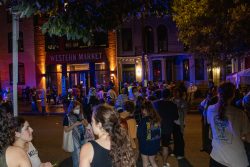Consider each of Georgetown’s buildings as members of a dysfunctional family: Healy would be the family’s scotch-swilling patriarch—dignified, but a touch stuffy. Copley would be his long-suffering wife, always quietly by his side. Leavey would be the cousin you used to think was cool, but turned out to be just as much of a fuck-up as the rest. Lauinger would be the hairy-backed uncle lounging in front of the TV after Thanksgiving dinner.
So how will the Southwest Quadrangle, the campus’ newest addition, fit into the Georgetown family? Its purpose is clear: keep 740 additional students living on campus (now upped to 900), put a new roof over the Jesuit community and feed the vast majority of the student population. But an entirely different question is, will the Quad turn out to be a party-boy like New South or a Village C East loner? One month in, hints are beginning to show, and one thing is certain: the Quad has more than enough awkward quirks to fit right in. It gets its job done, but if God is in the architectural details, Georgetown lost its faith long ago.
When a late-nineteenth-century university building boom hit forever status-obsessed Great Britain, the material chosen for the new schools’ halls was cheap, available brick. Located in industrial cities such as Liverpool and Manchester, these new universities’ shared and unique look readily contrasted with the pale stone common among Oxford and Cambridge’s ancient and revered colleges. The new universities’ appearance became a powerful symbol of a perceived second-class status—the term “red brick university” once carried a powerful stigma.
Today, the “red brick” stigma has disappeared. Though Georgetown’s oldest buildings are done in elegant stone, virtually all construction since the 1930s has been done in concrete and brick, from the puke-yellow 1960s-parochial-school look of Reiss and St. Mary’s to the nondescript “post-institutional” feel of Village C and the Leavey Center.
But of all these buildings, the product of 70 years of planning and construction, the Southwest Quad is easily the most attractive; it gets the “big things” right. Its visual presence is assertive, but not overwhelming. It features green space more prominently than any other campus residence. It takes advantage of impressive views of the Potomac River and its green banks. Inside, its halls are inviting and its rooms are cozy and well appointed. Despite the last-minute addition of over 100 residents, Kennedy, McCarthy and Reynolds Halls remain inviting and comfortable. Certain details stand out: For example, virtually every other brick building on campus features bland concrete trim; within the usual concrete, the Southwest Quad incorporates tasteful marble highlights.
But some of the building’s other aspects have drawn criticism from residents. For example, there are only 26 washers and 26 dryers for the Quad’s 900 residents. Also, though the three residence halls are adjacent to each other, there is no free passage between them, except at the ground floor. Ostensibly, this is intended to avoid the long, almost prison-like corridors of New South and the borderline behavior such a design may or may not inspire. But instead, it just makes it a pain in the ass to hang out with your friends. Over the past weeks, numerous students have taken advantage of the fact that fire exits between the building have been left open. However, in the near future, those exits are scheduled to be locked except during fire alarms.
Annoying as that may be, students reserve their greatest ire for the Rev. Leo J. O’Donovan, S.J. Dining Hall. For a facility that is seemingly everything New South cafeteria was not-airy, spacious and well lit-that criticism is, to say the least, unexpected. Plus, its sobriquet-Leo’s-is already de rigeur for dorm-room chatter and cell-phone banter.
But if any building’s earned a reputation yet, it’s the new feed trough. One McCarthy resident summed up the views of many students: “It’s the same shit in brand new packaging.”
“The whole place looks nice,” he said, “but the food tastes the same if not worse.”
Marriott is still serving the same flank steak and fried fish, but now you can’t blame the green tinge on the lighting. More Leo’s regulars noted the new two-story design as their biggest complaint. Entre?s, pasta, and vegetarian dishes are upstairs; grill items and pizza are downstairs. Desserts, cereal, sandwiches and salads are located on both floors. Even if you only eat what is upstairs, it’s still necessary to bus your trays in the oft-malfunctioning return machine downstairs. Many lament how it is now more difficult to choose what to eat and to find their dining companions.
“In New South, you looked around, and if they weren’t there, they weren’t there,” said Joyce Polsenberg (MSB ‘04). Now, she said, people are forced to navigate stairs, trays of food in hand. Polsenberg has seen several students trip down the stairs in O’Donovan, spilling their food.
One student, Ali Filipowicz (SFS ‘06) is so disappointed with the new facility that she wrote a letter to administrators in University Facilities and Auxiliary Services complaining about long lines and a lack of food, beverages, dinnerware and seating. Now, Filipowicz refuses to visit the campus dining halls. “I got so frustrated with all the problems that I refused to return,” she said.
Most students, however, have given the new cafeteria a “grace period,” and they’ve already seen some improvement. Leo’s two-story design may be an irreconcilable flaw, but chalk the other complaints up to opening-month jitters.
From 1928 to 1941, Finnish architect Eliel Saarinen conceived, designed and oversaw the construction of the Cranbook Academy in Bloomfield Hills, Mich. It was one of America’s earliest and most ambitious attempts at a completely integrated living, working, and learning environment. Saarinen designed every aspect of the Cranbrook campus, from its grand art museum to the chairs in the student lounges, as part of his unitary vision. Everything at Cranbrook has its place, and it fits harmoniously with the rest.
Very few other campuses, however, emerge fully born from the vision of a single architect. Most campuses instead undergo more constant change, growing and reinventing themselves as needs evolve with the times. Georgetown’s campus today is the product of such an evolution; needless to say, it had no Saarinen when the first buildings were constructed in the late 18th century. (In fact, only one structure, the McSherry building, survives today—it is the small stone shack between New South and Village C East; once a horse barn as well as the former Voice office, it is now the telecommunications office.) Today’s planners and architects must consider not only how a building fulfills its intended purpose, but also how it relates to those parts of campus built decades before.
While today’s first-years know the Southwest Quadrangle only as it is, seniors remember it when it was their first stop at Georgetown—the vast parking lot where they waited to move in on their first day on campus. Juniors remember a cavernous hole in the ground, filled slowly with reinforced concrete. Sophomores remember a lithe skeleton, erected by dancing cranes that woke them at wee hours from their beds in Village C West.
Through each of these stages of construction, we could hardly guess what effect the Southwest Quad would have—what effect it might have on where we gather, how we move from place to place, and quite simply, how the campus feels. Only now that the building is occupied can one judge whether it is a vital and integrated part of campus, or merely an addition.
Georgetown faced a similar change over the course of the 1980s, with the construction of ICC in 1982 and the Leavey Center in 1988. Before that, the northern end of campus was largely residential, dominated by Darnall, St. Mary’s (then a dormitory) and Henle Village. Virtually all student space was centered around Healy Circle; several student organizations, as well as such common destinations as Vital Vittles and the ill-fated Pub were located in Healy’s basement.
Once Vital Vittles, the bookstore and student offices moved to Leavey, along with a new lounge, coffeeshop and food court, the students moved with them. A well-defined pedestrian corridor developed along the campus’ western side, stretching from Leavey down past ICC, Copley and Healy before terminating at Lauinger. Smack in the middle of this corridor was the relatively new Red Square.
Today, Red Square swarms with students meeting friends between classes, smokers grabbing a quick fix, and most often, people of all sorts just passing through. In fact, Red Square’s status as the center of campus has a virtual imprimatur-in the eyes of the University, it is the campus’ sole official “free speech zone.” It is no wonder why-nearly all students are guaranteed to pass through the square, whether on their way to ICC for office hours, to Reiss for a 8:15 physics lab, or Uncommon Grounds to grab a chai.
But now with the addition of the Southwest Quad, 900 students don’t pass through Red Square on their way to hardly any building on campus. Rather, they have mostly chosen to walk up and down the hill by Leavey, often right in the middle of Tondorf Road—a situation both dangerous to students and inconvenient to traffic. It is no mystery why people choose to walk in the road; would-be pedestrian walkways are extremely uninviting: The sidewalk which leads past Village C West and Harbin is flanked by gas pumps and golf carts; the sidewalk by ICC is narrow, sunken and dark.
The corridor between the Southwest Quad and Leavey is liable only to get more congested with pedestrians. New business and science facilities are proposed for the areas where Parking Lot T and Harbin Field now lay. Even if a new “eastern corridor” is built as the campus develops, the problem of poor access to the Leavey Center will be a persistent annoyance. Today, access from any direction but the main corridor is unpleasant—a stifling, sterile stairway to the south, and the putrid, grungy loading dock to the north.
This situation only highlights how campus planners are forced to deal with previous designs whose ignorance is revealed only with each additional project. The mark of talented planners and architects is not only constructing a beautiful, functional building, but harmoniously integrating it into its surroundings. The Southwest Quad clearly passes the first test, but not the second. For now, students cannot be expected to continue using the steep and awkward steps between Harbin and New North, rather than claiming the middle of Tondorf Road. That is an ignorance already revealed.
*
A few weeks and 900 students have revealed some of the Southwest Quadrangle’s shortcomings. The future may reveal even more flaws, but it will also work to conceal them. The campus will continue to change, building on the Quad’s strengths and improving its weaknesses. The cafeteria may be improved within a couple months; the pedestrian question will likely endure for years.
But eventually they will be improved by future projects, just as the Quad did to other parts of campus. It made Village C and New South more central, connected McDonough to campus residences, and has generally turned the southwest corner of campus into a much more attractive place than what was once a paved wasteland dominated by the tennis courts and heating plant.
The Quad is part of the family now. It may be young; it may yet be jaded; it may not have revealed its entire personality. But it is still strapping and bright-eyed, aware of its flaws but not overwhelmed by them, ready to fit right in.




